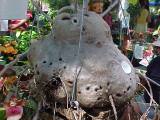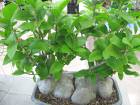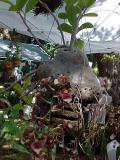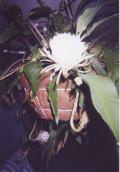This plant may be available to buy
Click the banana to see

|
Tropical Air Plants Epiphytic plants are among the most fascinating of all tropicals. Epiphytes include most orchids, many bromeliads, all staghorn ferns and other amazing plants like the famous 'Ant Plant' Ant Plant, Hydnophytum formicarum, which is actually an epiphytic shrub click pics to enlarge Amazing because epiphytic plants do not require soil to grow The Night Blooming Cereus, Selenicereus urbanianus, is a famous plant most folks didn't know is epiphytic click pic to read our article Because there is little or no soil, watering is, in the main, via humidity and retained moisture in organic matter collected at the roots Air plants derive their nutrition from just the air, rain water nutrients and decomposing matter (mostly leaves and dead insects) that may be caught among their roots or in their leaves For example, lightning produces nitrogen in the air that epiphytic plants absorb In the wild, most epiphytic plants are attached to tree bark as a brace but not in any way feeding off the tree. In this pic, an orchid is growing attached to the bark of a Mahogany tree. Here is a photo of an orchid wrapped around a plam tree so you can see how the roots wrap and hold on The bromeliad in this pic is from Mexico, is very rare, endangered and we lost the Latin name years ago. It is unique for at least the spiral curling of its leaves, but also has a fantastic bloom we saw on the mother plant. We have had it growing indoors for 5 years sitting in a terra cotta dish. Here is a photo of its roots There is zero soil in the pot holding this plant Once a week or so it is given a warm bath and its roots are allowed to soak for about 15 minutes. Then back into the tray (no standing water) in a shaded west window for another week or two Many folks think air plants are difficult to grow, especially the great myths about orchids. Actually, epiphytic plants are very easy because they are quite able to take care of themselves. All that is required is to provide the right conditions - usually, partial shade via bright or subdued indirect sunlight, wind protection, humidity, warmth and rain water Folks here in Florida like to mount air plants attached to pieces of wood or "boards" made of compressed fiber. Often a hook is inserted at the top and the plant is simply hung outdoors in a tree or just jammed into the branches We like organic foods for air plants. Generally this means using fish emulsion fertilizer. In the wild, all air plants get only low amounts of organic food from decomposing organic matter plus nitrogen from the air. Using fish emulsion is a natural. Some orchid growers use liquid orchid food, which is OK. For the staghorn fern, adding banana peels is a fine supplement To see more air plants, click here |



